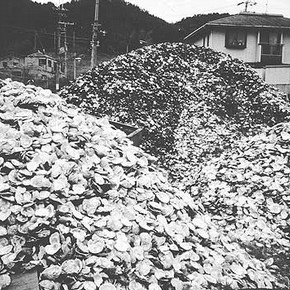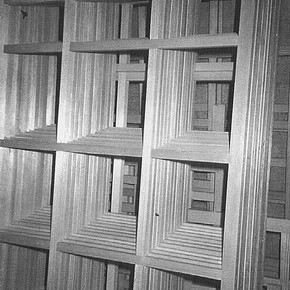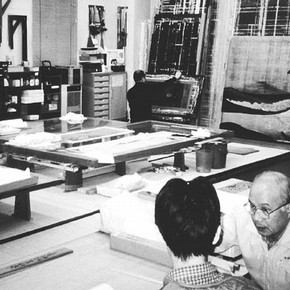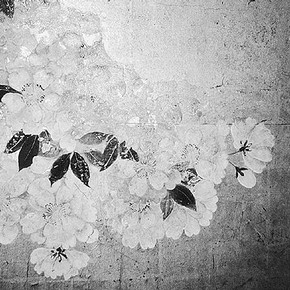Conservation Journal
July 1998 Issue 28
Report of a Research Trip to Tokyo and Kyoto in January 1998 founded by the Great Britain Sasakawa Foundation

Figure 1. Oyster shells at Uki are left to weather for 10-20 years to remove extraneous matter and to weaken the calcium carbonate for grinding the 'gofun'. Photography by Sandra Grantham. (click image for larger version)
The title of my thesis to be submitted to the Royal College of Art for a PhD later this year is Byobu & Fusuma: Developing an Approach to the Conservation of Japanese Screens Through Technical Study and an Investigation of Current Practices. I have been looking at traditional and contemporary treatments for the fragile paint on these paper screens and attempting to develop a suitable consolidation procedure.
In the process I have investigated the construction methods, the painting materials, techniques and styles (for which I spent a term studying at Kyoto Gedai City University of Arts in 1996) 1 and the screen's historical evolution within Japanese architecture. By combining the above with an understanding of the use and status of the screen in the society of its time and as a present-day collected art object, I have endeavoured to form a holistic survey, so that some fundamental conservation question may be reviewed.
The research trip was made - in part - to help identify attitudes to, and methods of, conservation training in Japan. This was part of a process to enable me to make an analogy and comparison of eastern and western approaches to the conservation of Far Eastern Cultural Properties.
I began by visiting the Tokyo Geijutsu Daigaku Nihonga Mosha (Tokyo National University of Fine Arts and Music, Copy Painting and Conservation Department) and the Tokyo National Research Institute for Cultural Properties. I was taken on a comprehensive tour of the departments by Dr Inaba, Conservation Scientist, where many works were seen in progress.
Also in Tokyo, a visit was made to the Handa Kyuseido Company Ltd, Oriental Painting Restoration Studio, sited in the Tokyo National Museum. The Handa studio is a member of Kokuho Soko Shi Remei (The Association of Master Mounters and Restorers of National Treasures), and so is one of the seven scroll mounting studios in Japan officially designated to work on National Treasures. Mr Masahiro Handa explained a number of the projects currently being undertaken, which included objects returned from museums in the United States, to be conserved under the scheme set up by Ikuo Hirayama of the Art Restoration Foundation in Tokyo. The conservator, Tanya Tomoko Uyeda, was a very helpful and able translator, making up for my regrettable lack of Japanese language. Her own comments, as an American/Japanese student training in Japan, were also invaluable.

Figure 3. 'Hone' made by Mr Takada of Kyoto. Photography by Sandra Grantham. (click image for larger version)
In Kyoto, I was invited to the studio of Mr. Michio Miyamoto, my 'Nihonga Mosha Sensei' (Professor of Japanese Copy Painting), from my term at Kyoto Geidai in 1996, to see his work in progress for seven painted fusuma for a new University building in Osaka. This gave me the opportunity to improve my understanding of the many techniques used by classical Japanese painters, of which Miyamoto Sensei has a great knowledge. Together we visited Mr Saburo Nakagawa of the Nakagawa Gofun Enogu Company Ltd, who gave us a tour of his pigment factory in Uji, south-east of Kyoto. I was able to see first hand the whole process of 'gofun' (ground oyster shell pigment) production, a white used exclusively in Japanese classical painting. I also watched the four-stage water levigation method for producing mineral pigments such as green 'rokusho' (malachite) and blue 'gunjo' (azurite).
I spent one week at the Usami Shokakudo Company Ltd In Kyoto, also a member of The Association of Master Mounters & Restorers of National Treasures. I visited both the studio in the Kyoto National Museum Conservation Centre and the studio on Horikawa Dori. Being a 'fly on the wall' observer proved to be most useful. I was able to watch many different processes in action, receiving full and careful explanations from the American Master Mounter Apprentice of seven years standing, Mr Andrew Hare, who was extremely patient with my many questions. I also spoke (through Mr Hare's translation) to Mr Naito who takes on most of the initial training of apprentices. It was an illuminating conversation, uncovering attitudes which I had not entirely foreseen.

Figure 4. A view of the Usami Shokakudo scroll mounting studio at Horikawa Dori, Kyoto. Photography by Sandra Grantham. (click image for larger version)
During my time at the Studio, a paper dealer brought samples for me of the 'sekishu' papers used traditionally to line 'hone' (wooden lattice frames) for 'karibari' drying boards and screen panels. 'Karibari' boards are used both in the East and the West to flatten and dry conserved works of art. I also went to the Kitano Shrine monthly antique market to find 'dai fuku cho' (old account books). The seasoned paper from these was used for inner hone linings in the conservation of 'byobu' (folding screen) panels.
Mr Usami took me to Nijo Castle, also in Kyoto to the studio of Professor Toshiaki Ohno, who is in charge of a project involving the copying of all the endangered painted screens in the castle. Over one thousand wall panels will eventually be replaced by the copies being produced, so that the originals can be preserved in safe storage. We discussed the pigments and binders used and I was able to photgraph many of the original screens.
This was followed by a visit to Mr Takada's carpenters workshop, where 'hone' were made to replace those which had degraded in 'byobu' being conserved. I was shown the various woods used at the workshop, the great array of planes and saws, and discussed methods used. I also visited Mr Nishimura, a brush maker in Kyoto, to obtain hand-made 'shigoki bake' (badger hair pasting brushes) made specially for several members of the V&A Paper Conservation Department. These invaluable brushes are not easily obtainable in England and Mr Nishimura's are particularly fine.
Mr Usami was a gracious and generous host, as was everyone I encounered during my stay. I am indebted to the Great Britain Sawakawa Foundation and Mr Rupert Faulkner of the V&A for making this trip possible, through which I have gained valuable insight and a little more understanding.
Sandra Grantham is funded by The Wingate Foundation, The Rio Tinto Company and The Great Britain Sasakawa Foundation.
Reference
1. Grantham, S., Painting in Japan, V&A Conservation Journal 24, July 1997, p.22-23.
July 1998 Issue 28
- Editorial - Education and Training
- An Exploration of the original appearance of Nicholas Hilliard's portrait miniatures using computer image manipulation
- Outer Limits: The Ups and Downs of Being a Student on a Collaborative MA Couse
- Archaeopteryx - a wing and a prayer
- Internships at the V&A
- Six-month Internship in Decorative Surfaces
- Life as an Intern
- The External Examiner
- Out of the Frying Pan...
- Report of a Research Trip to Tokyo and Kyoto in January 1998 founded by the Great Britain Sasakawa Foundation
- Review of 'Care and Preservation of Modern Materials in Costume Collections'- New York 2-3 February 1998
- Printer Friendly Version
